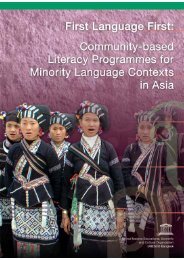Part II.pdf - MTB-MLE Network
Part II.pdf - MTB-MLE Network
Part II.pdf - MTB-MLE Network
You also want an ePaper? Increase the reach of your titles
YUMPU automatically turns print PDFs into web optimized ePapers that Google loves.
Notes to Table 1:<br />
1<br />
‘Local languages used in education’ states whether local languages or languages of wider communication (LWC)<br />
(i.e. other than national or official language) are used in education practice at any level or in any system of basic education (such<br />
as pre-primary, primary or lower secondary education, formal or non-formal system, run by the government or other stakeholders,<br />
such as local communities, NGOs etc.). Yes means that both instruction and some learning materials are in local languages.<br />
Therefore, situations in which teachers use a local language or a LWC orally in addition to the official language of instruction are<br />
not included here.<br />
2<br />
‘Local languages used as media of instruction’ refers to a situation in which local languages are used as the actual media of<br />
instruction at any level or system of basic education. Yes in bold means that local languages are used only in non-formal education<br />
by NGOs.<br />
3<br />
‘Multiple languages in government system of education’ refers to a situation in which more than one language is used in the<br />
government system of education (either formal or non-formal at any level of basic education as stated above). Thus, private<br />
formal schools or education projects by non-governmental organizations are not included in this column. Yes in bold means that<br />
despite more than one language being used, local languages as such are not.<br />
4<br />
‘Languages used in the government system of education’ lists the names of the languages used in the government system.<br />
Details of other languages are given in each country case. LWC = language of wider communication, local language, see definitions<br />
in Appendix 1.<br />
5<br />
‘Access to education in L1 (percent)’ refers to the estimated percentage of a nation’s total population having access to education<br />
in learners’ first language (L1). The criterion is linguistic, i.e. the proportion of population speaking as the mother tongue one of<br />
the languages used in education. Source: Walter (2004). Cambodian, Lao and Thai situations estimated by the author on the<br />
basis of data from Chazée (1999), Grimes (2000), Kingsada (2003), National Statistical Centre (1997), Schliesinger (2000, 2003),<br />
and Smalley (1994).<br />
6<br />
7<br />
Table 1. Local Language Use in Basic Education for China and South-East Asia<br />
Country<br />
Local Multiple Languages<br />
Local<br />
languages languages in used in the Access to Total number<br />
languages<br />
used as government government education in of languages<br />
used in<br />
education 1 media of system of system of L1 (percent) 5 spoken 6<br />
instruction 2 education 3 education 4<br />
Mandarin,<br />
China Yes Yes Yes LWCs, local 69 201<br />
languages<br />
Brunei No No Yes Malay, English 2 17<br />
Cambodia Yes Yes Yes<br />
Khmer,<br />
local languages<br />
90 19<br />
Indonesia Yes No Yes<br />
Indonesian,<br />
LWCs<br />
10 726<br />
Lao PDR No No No Lao < 50 7 82<br />
Malaysia Yes No Yes<br />
Malay, English<br />
Mandarin, Tamil,<br />
Telugu, Punjabi,<br />
45 139<br />
local languages<br />
Myanmar Yes Yes No Myanma 61 107<br />
Philippines Yes Yes Yes<br />
Filipino,<br />
English, LWCs<br />
26 169<br />
English,<br />
Singapore No No Yes Mandarin, 33 21<br />
Malay, Tamil<br />
Thailand Yes Yes Yes<br />
Thai, local<br />
languages<br />
< 50 75<br />
Viet Nam Yes Yes Yes<br />
Vietnamese,<br />
local languages<br />
91 93<br />
‘Total number of languages’ spoken in a given country. Source: Grimes (2000).<br />
Chazée (1999, 7, 14) claims that only about 35% of the population of Lao PDR are Tai Lao (also called Lao Loum or Lowland<br />
Lao). He maintains that other ethnic groups related to the Lao are included in higher figures of Lao population. However, there<br />
are no data on whether other Tai groups speak Lao as their mother tongue or not.<br />
111
















